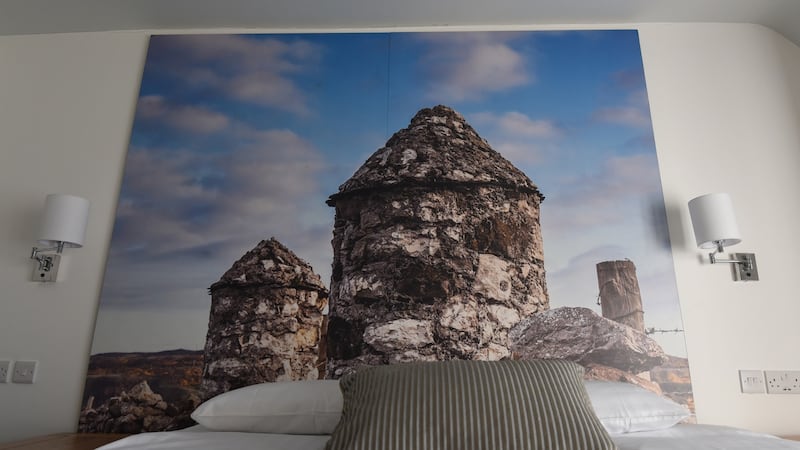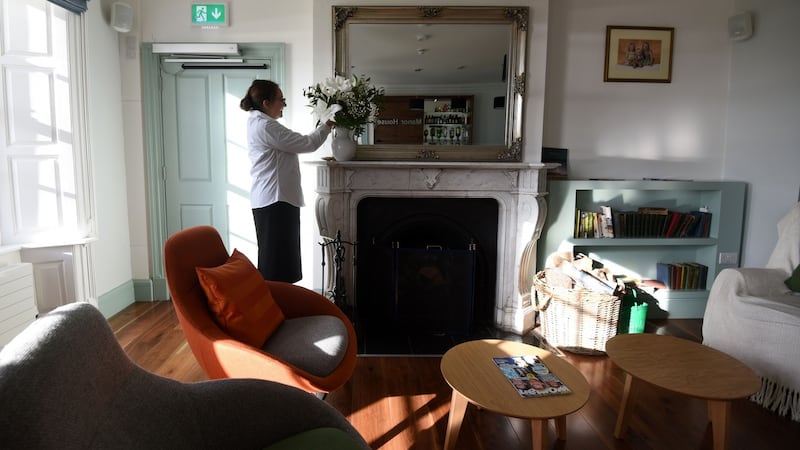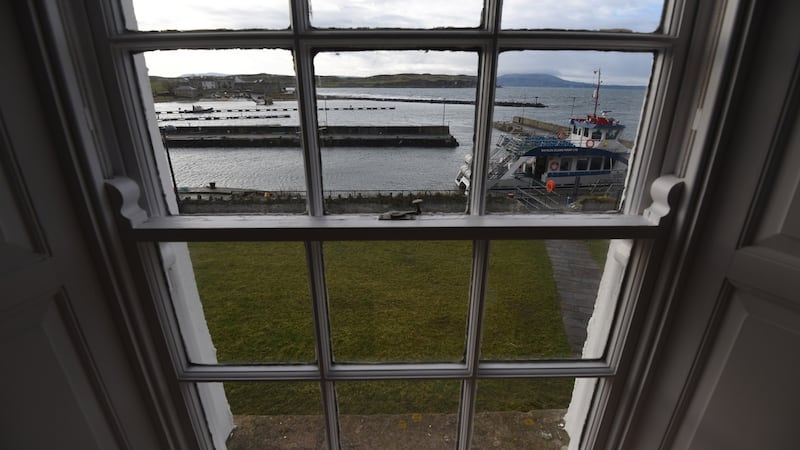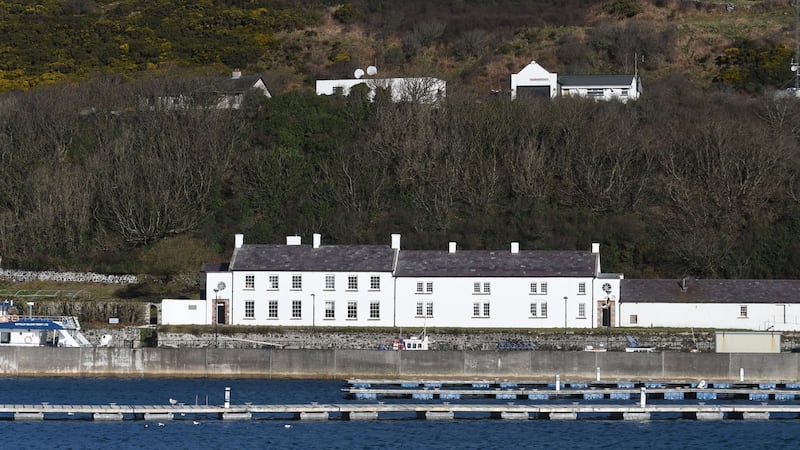When Robert Gage was appointed rector of Rathlin, off the Antrim coast, he was described as "completely lord of the island who banishes his subjects to the continent of Ireland for misconduct or repeated offences against the law".
Same “lord” expected his own ferry crew to wear uniform – a livery of blue and white as they rowed him to shore – and he didn’t have to walk far before stepping on board. He and his family could survey sea conditions from the safety and comfort of their 18th century waterfront home.
Some 170 years later, the Georgian manor has passed from several generations of a landed class to the island community . . . almost. The property, now owned by the British National Trust, has been leased by Rathlin Development and Community Association (RDCA), which spent several years refurbishing it as a guesthouse and inn.

Travelling out by ferry from Ballycastle on seas tormented by Storm Doris – and with Storm Ewan a day away – one is struck by the prime harbour setting of the long low two-storey building. Workrooms for weaving, a stone archway and walled garden overlooking Rathlin Sound are among the features of the home occupied by one family for two centuries.
When the Rev John Gage bought the entire island from the fifth Earl of Antrim in 1746, it had already endured several massacres – with Sir Francis Drake associated with one of the most bloody – and the population had been wiped out twice. The island community survived the Great Famine by relying on fish and seabirds and the generosity of donations, including one from a firm of London underwriters which acknowledged the residents' "honesty at shipwrecks".

Treacherous tidal waters on the Sea of Moyle separating the outcrop from the Antrim and Scottish coasts have claimed many vessels, with a Commissioners of Irish Lights navigation marking the loss of HMS Drake a century ago in October, 1917. Still, the sea also provided a good income. Kelp production was an integral part of the domestic economy, along with corn milling and other enterprises, and island historian, the late Wallace Clark,has described the family's influence as largely benevolent.
Writing in Rathlin – Disputed Island, Clark described the Manor House as "one of the most delightful" homes he had ever encountered, with "the light from the water, dappled as it reflects from the tangles of maidenhair seaweed at the edge of the bay" shining "into the deep windows all along the south side".

Brigadier Rex Gage, who died in 1973, was the last of the family to live permanently there and the building fell into disrepair. After Rathlin diver Tommy Cecil rescued hot air balloonist Sir Richard Branson in 1986, the house was restored with a donation of £25,000 (€29k) from the businessman.
In 1998, it was acquired by the National Trust and opened as a guesthouse. Its restaurant hit headlines in 2010 when a booking for Britain’s Prince Edward and his wife Sophie was cancelled at the last minute and the royal couple had to partake of sausage rolls in McCuaig’s bar.
When the development association approached the National Trust several years ago to lease the building, it had an idea in mind. It had been inspired by a social enterprise model developed by the Bromley-by-Bow district in the east London borough of Tower Hamlets.
"We set up a community interest company as a trading arm to run it as a hotel for the benefit of the island,"RDCA chairman Michael Cecil explains. "Our plan was to keep it open all year-round, and generate local employment."
Revenue from marine resources, including seabed licensing for oil production in the North Sea, has paid for the extensive overhaul. The British Crown Estate’s Coastal Communities Fund – which has no equivalent south of the Border – awarded the island association some £750,000 (€965,000) for the ambitious project which has been several years in gestation.
“The total budget came to about £1 million sterling as the Northern Ireland Department of Agriculture and Rural Development made up the shortfall,”Cecil says.
Conservation architects Donnelly O’Neill came up with the plan,which required extensive remodelling of the building and installation of en suite bedrooms. Furnishings of oak and linen, headboards with images by island photographer Tom McDonnell, and a mixture of timber and carpeted flooring were selected by interior designers Work Rest Play, also of Belfast.

However, the biggest challenge came after the fit-out, according to Cecil. The association was approached by several major leisure interests with an eye on the prime location and a fast seasonal buck.The boomerang-shaped island of basalt and chalk is a special area of conservation, however, and attracts a particular type of visitor. It is a magnet for bird-watchers and hill-walkers, and its tourist footfall has been growing since it acquired a fast ferry run by Cape Clear islander Ciaran O’Driscoll.
One of the island's three lighthouses, Rathlin West, has been refurbished for accommodation under the Commissioners of Irish Lights "Great Lighthouses of Ireland" tourism initiative. The Royal Society for the Protection of Birds which provides wardens for the island colonies of puffins, guillemots, fulmars, kittiwakes and razorbills, has also invested in its seabird centre.
Therefore, the RDCA knew that Manor House required a particular approach which was sensitive to a community focus on sustainability.This time last year, it advertised for a manager, or management couple. When Ballycastle guesthouse owner Genevieve McLernon spotted the notice in a local newspaper, she remembers her initial response: “I can do that”.
The former community nurse has run a successful guesthouse in Ballycastle since 1996, two years before the Belfast Agreement. Her husband Brian, who worked in Saudi Arabia with Masstock for many years and latterly set up a recycling business, is a keen sea angler who knows where the best mackerel, lythe (pollack) and glashan (coley) can be caught, and has visited Rathlin many times over the years.

The island association has signed a five-year contract with the couple, which allows them to run the Manor House as a business, while paying the association the sum of £1,200 (€1.4k) a year or 5 per cent of gross profits after wages and other costs. The association will reinvest any profit it makes back into the community, Mr Cecil explains.
Cecil’s role is voluntary, as is that of his committee and board of directors, and he points out that community consent has been required at every stage. While that has its challenges – down to agreeing on the colour of lampshades – the benefit is that “everyone feels involved”.
Nine staff include London-born Teresa Frecker who previously worked in the Manor House during its National Trust days and has lived on the island for many years . The one drawback is accommodation for staff, which is in short supply. "That's our next challenge," Cecil says.
“For the first time, the island population is rising, we have 10 new social houses, nine children in the primary school, several babies on the way and we have almost 100 per cent employment,” he says. The Manor House is the island’s latest adventure, and one which may inspire other communities living on the north Atlantic rim.
PANEL
Eight walks with stunning views of Scotland’s Mull of Kintyre and Antrim’s Fair Head on a clear day are among a myriad of activities on Rathlin island. Its “upside down” lighthouse on the west of the island is an international seabird centre, renowned for its colony of “sea parrots” or puffins, and its archaeology and geology extends from Brockley axes and Viking burial sites to Giant’s Causeway-type formations on its basalt shoreline.
The Manor House Hotel has 11 rooms, ranging from £65 (€75.50)per night for a single room to £95 (€110) for a double or twin and £125 (€145) per night for a family, and there is full disability access. The restaurant is open for evening meals during the week for guests, and all day/evening at weekends. Daily ferry sailings across the 9.5km sound between Ballycastle and Rathlin run all year, weather permitting, and booking is advised.
For reservations, phone (00 44)28-2076 0046 or email info@manorhouserathlin.com
For ferry bookings, contact Rathlin Island Ferry Ltd at (0044) 28-2076 9299 or email info@rathlinballycastleferry.com
Lorna Siggins was accommodated for one night on Rathlin by Manor House













